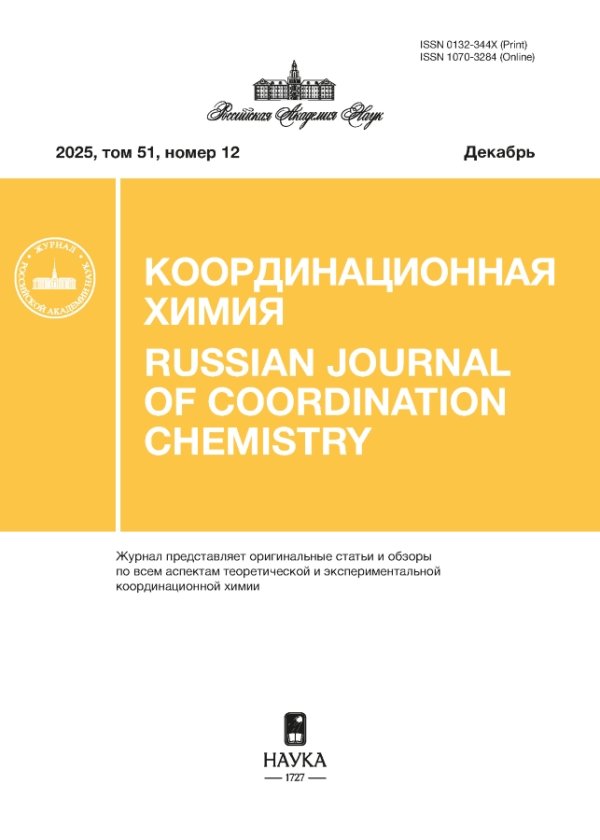Том 49, № 6 (2023)
Статьи
Новый 5-н-C4H9-C2B9-карборановый лиганд и комплексы рутения на его основе
Аннотация
По реакции кросс-сочетания 9-иод-орто-карборана с н-бутилмагнийбромидом получен 9-н-бутил-орто-карборан, взаимодействием которого со щелочью в кипящем этаноле синтезирован новый нидо-карборан [5-Bu-7,8-C2B9H11]– (I), содержащий н-бутильный заместитель в нижнем поясе корзины. Его взаимодействие с RuCl2(PPh3)(Ph2P(CH2)4PPh2) привело к образованию соответствующего клозо-комплекса рутения(IV) 3,3-(Ph2P(CH2)4PPh2)-3-H-3-Cl-9-Bu-клозо-3,1,2-RuC2B9H10 (II), охарактеризованного методами двумерной ЯМР-спектроскопии. Установлено, что полученное производное при нагревании способно реагировать с четыреххлористым углеродом с образованием 17-электронного комплекса 3,3-(Ph2P(CH2)4PPh2)-3-Cl-9-Bu-клозо-3,1,2-RuC2B9H10 (III). Структура III определена методом РСА (CCDC № 2180761). Проведенные электрохимические исследования показали, что комплекс III аналогично ранее исследованным рутенакарборанам претерпевает обратимый переход Ru(II) → Ru(III).
 323-332
323-332


Взаимозамещение лигандов в реакциях комплексообразования никеля(II) с клозо-декаборатным анионом
Аннотация
Изучена реакция комплексообразования никеля(II) с клозо-декаборатным анионом в воде и ацетонитриле. Выделены комплексы состава [Ni(solv)6][B10H10] (solv = H2O (I) или CH3CN (II)). Комплексы охарактеризованы методами элементного анализа и ИК-спектроскопии. Из системы ацетонитрил–вода выделен комплекс [Ni(CH3CN)5(H2O)]0.75[Ni(CH3CN)4(H2O)2]0.25[B10H10] · 0.5H2O (III). Структура комплекса III определена методом РСА (CCDС № 2224702). Предложен механизм взаимозамещения лигандов в реакции комплексообразования никеля(II).
 333-340
333-340


Бромоантимонаты(III) vs бромовисмутаты(III): отличия в склонности к образованию полиядерных комплексов
Аннотация
Cинтезированы бромидные комплексы Sb(III) с двухзарядными катионами на основе пиридинов – (PyC3)3[Sb2Br9]2 (I), (PyC4)[Sb2Br8] (II), (PyC5)2[α-Sb4Br16] (III), (PyC6)2[Sb2Br10] (IV), (4-MePyC2)2-[Sb2Br10] (V), (4-MePyC3)2[α-Sb4Br16] (VI), (4-MePyC5)2[α-Sb4Br16] (VII) и охарактеризованы методом РСА (CCDC № 2204718–2204724). Представлено сравнение структур данных соединений с родственными бромовисмутатами(III).
 341-346
341-346


Строение N-метилбензоилгидроксамата меди(II) в кристаллическом состоянии и в растворе
Аннотация
Методами рентгеноструктурного анализа в кристаллическом состоянии и стационарной спектроскопии ЭПР в растворе изучено геометрическое строение соединения CuL2, где L = R1N(O)–(O)CR2, R1 = Me, R2 = Ph, (I). В кристаллическом состоянии I представляет собой многоядерный комплекс цепочечной структуры. По данным ЭПР, в замороженном растворе комплекс I существует в виде трех форм: двух моноядерных и одной биядерной. Определены магнитно-резонансные параметры и концентрации форм в замороженном растворе. В рамках неограниченного метода теории функционала плотности (DFT) выполнены расчеты электронной структуры комплекса с полной оптимизацией геометрии всех систем.
 347-353
347-353


Аддукты стерически затрудненного катехолата теллура с простыми эфирами
Аннотация
Получены и охарактеризованы методом рентгеноструктурного анализа аддукты 3,6-ди-трет-бутилкатехолата теллура(IV) (Te(Cat36)2) с 1,2-диметоксиэтаном (Dme), бис(2-метокси)этиловым эфиром (diglyme) и краун-эфиром 18-краун-6 (18c6) – [Te(Cat36)2(Dme)]2 (I), [Te(Cat36)2(diglyme)] (II), [Te2(Cat36)4(18c6)] (III) соответственно (CCDC № 2208717 (I), 2208718 (II), 2208719 (III)). Комплексы также охарактеризованы методами ЯМР- (1H, 125Te) и ИК-спектроскопии.
 354-359
354-359


Темплатный синтез трехъядерного комплекса кобальта(III) с лигандами на основе диарилимидазолов: синтез и свойства
Аннотация
Темплатной реакцией 2,2'-(1H-имидазол-4,5-диил)бис(4-этилфенола) (L) и бис(2,2-бипиридин)дихлорида кобальта(II) в присутствии диазабициклоундецена получен трехъядерный комплекс кобальта(III) [(Bipy)5Co3(L)2](Cl)3 (I), выделенный в индивидуальном виде и охарактеризованый при помощи элементного анализа, циклической вольтамперометрии, спектроскопии УФ-вид. и рентгеновской дифракции (СCDC № 2201135). Согласно полученным данным, ионы кобальта в трехъядерном комплексе I имеют степень окисления +3, и реакция комплексообразования протекает с окислением исходных ионов кобальта(II).
 360-366
360-366


Циклопентадиенильный комплекс лютеция с дианионом 2,6-ди-трет-бутилантрацена
Аннотация
Взаимодействие 2,6-ди(трет-бутил)антрацена с графитидом калия и тетрагидрофуранатом моноциклопентадиениллютецийдихлорида в среде ТГФ приводит к антраценидному комплексу [(η5-C5H5)Lu(η2-2,6-tBu2C14H8)(THF)2] (I), строение которого установлено методом РСА (CCDC № 2215512). Комплекс I кристаллизуется в орторомбической группе P212121. Продемонстрирована структурная жесткость узла Lu(O)2Cp(антрацен). Методами ЯМР продемонстрировано сохранение строения комплекса I в растворе.
 367-374
367-374


Новые сукцинатсодержащие полимеры уранила: синтез и строение
Аннотация
Проведены синтез, рентгеноструктурное и ИК-спектроскопическое и термографическое исследования двух сукцинатсодержащих полимеров уранила: NH4[UO2(Suc)(HSuc)] ∙ H2O (I) и [UO2(Suc)(H2О)2] (II), где Suc = сукцинат-ион \({{{\text{C}}}_{{\text{4}}}}{{{\text{H}}}_{{\text{4}}}}{\text{O}}_{4}^{{2--}}\) (CCDC № 2202634 и 2202635 соответственно). Основными структурными единицами кристаллов I являются бесконечные зигзагообразные цепочки состава [UO2(Suc)(HSuc)]– с кристаллохимической формулой АQ02B01 (A = \({\text{UO}}_{2}^{{2 + }},\) Q02 = \({{{\text{C}}}_{{\text{4}}}}{{{\text{H}}}_{{\text{4}}}}{\text{O}}_{4}^{{2--}},\) а B01 = = \({{{\text{C}}}_{{\text{4}}}}{{{\text{H}}}_{{\text{5}}}}{\text{O}}_{4}^{ - }\)). Установлено, что в структуре II электронейтральным цепочкам [UO2(Suc)(H2О)2] соответствует кристаллохимическая формула \({\text{{А}}}{{{\text{Q}}}^{{02}}}{\text{{М}}}_{2}^{1}\) (A = \({\text{UO}}_{2}^{{2 + }},\) Q02 = \({{{\text{C}}}_{{\text{4}}}}{{{\text{H}}}_{{\text{4}}}}{\text{O}}_{4}^{{2--}},\) а М1 = H2О). C помощью метода молекулярных полиэдров Вороного–Дирихле проведен анализ межмолекулярных взаимодействий в структурах I и II.
 375-382
375-382


К пятидесятилетию Константина Юрьевича Жижина
 383-384
383-384












